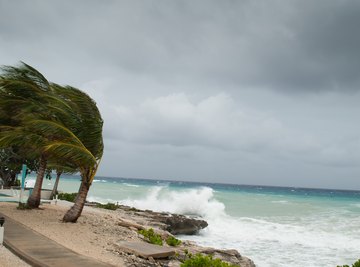
Hurricanes have very strong spiraling winds and produce a large amount of rainfall. They grow up to 600 miles across and create wind velocities of 75 to 200 mph. They might last for over a week, moving across the ocean at 10 to 20 mph or faster. Severe hurricanes that reach landfall cause serious damage to buildings, with strong winds and flooding storm surges. Experiments demonstrate some typical behaviors of hurricanes.
Hurricane Tracking
The teacher or parent obtains a tracking map, which allows accurate tracking of a hurricane at the precise time it forms and begins to move. The teacher has only to listen to the weather reports or follow the coordinates of the storm by visiting the National Hurricane Center, which supplies the current longitude and latitude of any current storm system. Instruct the kids to place push pins in the map to track the hurricane's path with the option of using colored pins to denote any change in its strength, according to it changing classification.
Storm Nomenclature
The teacher explains that a storm which has winds of 74 mph and faster is considered a hurricane, but the storm is given different names according to location around the globe. By using a large globe or Mercator map, the teacher explains that the name "hurricane" is used when the storm arrives in the Gulf of Mexico, the Atlantic or in the eastern Pacific Ocean. The same type of storm receives the name of "typhoon" in the western Pacific Ocean near Japan, and is called a cyclone when it happens in Australia, the Bay of Bengal and the Indian Ocean.
Hurricane Strength
The teacher fills a large bowl of water a little over half full, ties a paper clip on the end of a foot-long string and instructs a student to swirl the contents of the bowl counter-clockwise with a wooden spoon to get a moving rotation. Another student places the paper clip end of the string into the water, holding the string aloft. The students observe where the most motion of the paper clip occurs by its placement from the center or "eye" on outward to the edge of the bowl. This experiment shows the strength of rotating winds inside a hurricane.
Water Depth -- Wind Speed
The teacher places a large baking dish on a flat surface. A student bends a flexible straw so it has an L-shape, and the longest part of the straw is at the bottom part of the L. The teacher tapes the straw on the end of the baking dish so the short end of the straw faces upward and the long end points across the length of the dish. Water is added to the dish until the level reaches just under the straw. One of the students blows through the straw with various pressures, and moves the straw up and down in height. Another student measures the height of the ripples with a ruler and notes the difference in ripple elevations each time. Increasing the water depth also produces different results.
References
About the Author
Chris Stevenson has been writing since 1988. His automotive vocation has spanned more than 35 years and he authored the auto repair manual "Auto Repair Shams and Scams" in 1990. Stevenson holds a P.D.S Toyota certificate, ASE brake certification, Clean Air Act certification and a California smog license.
